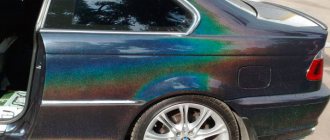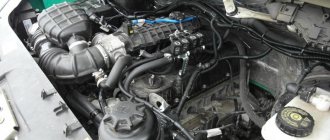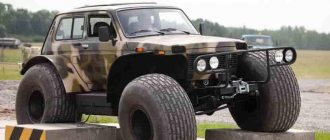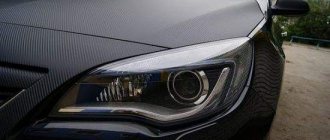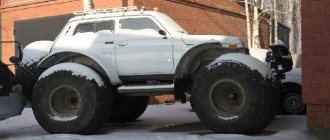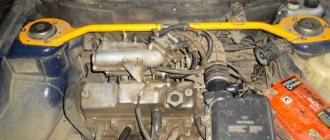No comments
Rating:
Tags:Soundproofing
Before you begin work on soundproofing your car, decide what goal you want to achieve: improving the sound of music in the car, reducing the audibility of squeaks, or simply increasing comfort. Many motorists are interested in how to properly make sound insulation in a car with their own hands, if they have never done anything like this before. You should soundproof your car (especially if you have a limited budget) in stages. First - the doors, then - the hood, trunk, etc.
Before starting work, it is better to first make sure that you have stocked up with everything you need. The arsenal should include:
- Hairdryer for construction work (using a hair dryer at home is strictly not recommended).
- Roller for leveling and rolling insulating material over the surface of a car.
- Scissors for cutting insulating material.
- Solvent (a White Spirit type degreaser can be used).
Car sound insulation diagram
See also:
Sound insulation of car fender liner
Types of noise
In order for your own car soundproofing to be correct and effective, we will try to understand where the noise comes from.
Body vibration. When a car moves, vibration is transmitted from the running engine and from the road through the car's suspension. And since the car body is, roughly speaking, a large tin can that collects all these vibrations and converts them into various sounds.
An external air flow through which the car seems to break through. Whatever one may say, the car body, although it is made as aerodynamic as possible, is still a sail. And the noise of the passing air flow is very high.
Wheels are a serious source of noise. Rubber, or rather its tread, constantly hits the road when moving. These millions of micro-beats create a constant hum that increases with speed. If the tires are studded, then the noise is many times greater. Wheel noise is transmitted mainly through the wheel arches.
I never use studded tires and I believe that they only cause harm to both the car and the roads.
Sound insulation elements
Do-it-yourself soundproofing of a car has the main goal - to make it as comfortable as the most luxurious car and, of course, save an extra 50 thousand rubles.
Let's break our body into elements, isolating which you will achieve the ideal effect, believe me, sound insulation rules.
Soundproofing a car roof
The main element that makes a lot of noise. The noise comes from a large resonating flat surface, external wind and other street noise.
Soundproofing a car floor
The most vulnerable element, which perceives numerous small objects, sand, gravel, and the hum of rubber. It resonates with the road, absorbs shock from the suspension, 2-3 layers of noise insulation will reduce it by 95%.
Sound insulation of the hood
The first element that receives and transmits the main vibration from engine operation to the body. Proper sound insulation will block vibration, make the engine run quiet, and minimize noise coming from the engine compartment.
Soundproofing car doors
Perhaps the lion's share of street noise enters the cabin from the doorways. Here you need the maximum number of layers of soundproofing material. Soundproofing car doors presents an additional challenge in that they contain acoustic systems that require a special approach for high-quality sound.
Trunk noise insulation
Although the trunk does not bring much noise into the cabin, its sound insulation should not be ignored. It also emits a lot of street noise, plus it catches and transmits the roar of the exhaust pipe. Vibration-damping and noise-absorbing layers for the trunk will not be superfluous.
Noise insulation of wheel arches
An important and mandatory area for soundproofing. Automakers often ignore soundproofing of this element. Meanwhile, wheel arches are one of the main suppliers of low-frequency sounds. Impacts of pebbles from the road, sand hitting the bottom, tire noise, etc. In addition, arches are most susceptible to corrosion, wear of the surface of the underwheel space, and rotting of plastic. Therefore, in addition to noise insulation, the arches should be protected from these harmful influences.
Soundproofing dashboard
The dashboard is the front panel of the car. It is not always solid, so over time this element becomes a source of squeaks in the cabin. The plastic from which the panel is made and its elements at the joints make noise. Soundproofing the dashboard will eliminate all squeaking problems.
Soundproofing of wheel arches and trunk
When it’s your turn to soundproof your car’s wheel arches with your own hands, you should start with the rear wheel well. It is better to treat it with a noise-insulating coating over the entire area. In this case, you should also treat the fender liners and the plastic covering of the trunk using the anti-squeak agent Bioplast. Soundproof fender liners can significantly reduce the noise emitted by the car while driving. However, the most important thing is the wheel arches. If you carefully insulate them, the impact of small pebbles on metal will not be heard in the cabin while driving. And in winter, the grinding of winter tires will not cause discomfort to passengers.
Noise insulation of wheel arches
How to soundproof this area? Very simple! Soundproofing of wheel arches is carried out in the following sequence:
- Remove the fender liners and put them aside (they, being good sound insulators in themselves, will still be useful to you).
- Clean the niches from dirt and dust.
- Apply a thick layer of soundproofing material to the inner surface of the niche. Use vibroplast "Gold".
- Treat the niches with an anti-gravel agent - it will kill two birds with one stone: protect the interior from noise and protect the surface from rust.
If your car has plastic fender liners, they can also be covered with sound-proofing material. To do this, vibroplast “Silver” is applied to the outer side, as well as biplast (to ensure the proper level of sound absorption). After this, the part is placed in its place. If you do everything correctly, the impact of stones, dirt and debris on the wheel arches will no longer annoy you.
Materials used and their properties
StP Vibroplast Silver
Vibration absorber. On self-adhesive, with foil. There is no need to heat up when applying the sticker. Anti-corrosion properties, does not rot, sealant. Silver thickness is 2 mm, made with markings in 5 cm squares, for cutting during installation. Weight 3 kg/m2.
Application: sound insulation of doors, roof, trunk, hood, floor.
StP Vibroplast Gold
The properties of Gold are the same as those of Silver, only it is a little thicker, and of course absorbs vibrations more. Weight 4 kg/m2. Thickness 2.3 mm.
Vibration isolation StP Bimast Bomb
The best vibration absorber. Sandwich made of bitumen and rubber composition, foil. Requires heating up to 50 degrees during installation. High vibration absorption efficiency. Weight 6 kg/m2. Thickness 4.2 mm. Considered ideal for audio preparation.
Application: sound insulation of tunnels, arches, muffler area and driveshaft.
StP Splen 3004
Soundproofing. Self-adhesive. A good heat insulator, non-hygroscopic and does not rot. Work from -40 to +70 degrees. Thickness 4 mm. Weight 042 kg/m2.
This material for the second layer is glued to the vibro-material at a temperature of 18 - 35 degrees, on a degreased surface.
Application: front panel, tunnels, arches, doors,
StP Biplast 5 anti-creak
Sound absorber and seal. Anti-creak. The base is polyurethane, self-adhesive. Waterproof, rot-resistant, heat insulating. In the cold it retains its properties. Thickness 5 mm. Weight 0.4 kg/m2. Biplast 10 - 10 mm.
StP Accent 10
Sound absorber. Elastic polyurethane foam, self-adhesive. Thermal insulator. Good frequency range, absorbs up to 90% of noise. Thickness: 10 mm. 0.5 kg/m2. Operates from -40 to +100 degrees C.
It is used for soundproofing the hood and in the engine compartment.
Madeleine
Thickness 1-1.5 mm. Fabric base, self-adhesive. Seal.
Applies gaps between various elements of the body, instrument panel, air ducts.
This is not a complete list of materials used for vibration and sound insulation. It is possible to use any with similar characteristics, for example, there is a vibration-isolating “Vikar” thickness. 1.5 mm. and noise-insulating “Shumoff” 4 mm.
Main stages of sound insulation
//www.youtube.com/watch?v=Xo-nc_F1WSs
What tools are used for the job if it is decided that soundproofing a car with your own hands will still be brought to life?
- Construction hair dryer (only construction hair dryer, with high heating temperature);
- rolling roller (for good contact with the body surface);
- scissors (preferably more powerful);
- stationery knife (to remove air from bubbles under the material);
- degreaser liquid (solvent, acetone, white spirit).
Having prepared the tool, we dismantle all the casing elements as much as possible and clean them from dirt and dust. The more parts of the interior trim you remove, the better and more you can glue vibration insulation, and the better quality your sound insulation will be.
Vibration insulation is applied as the first layer. If the material requires heating, then of course heat it to the required temperature (40 -50 g BiMast Bomb) and stick it on. If the material is self-adhesive, then heat the surface as required by the corresponding material (18 - 35 gr. Silver, Splen).
Then we press it well with a stitching roller. We roll it well until the foil texture disappears. The material must be pressed well, there should be no air bubbles under the material, otherwise corrosion may form there and the material will peel off. It is better to glue the vibra end-to-end at the joints.
But it is better to glue soundproofing sheets in large pieces, otherwise there will be no effect. It is better to glue according to pre-cut templates.
Vibration and sound insulation of a car roof
After all the trim has been removed from the interior of your car, thoroughly degrease the surface, cut out the vibration insulation sheets, and proceed with the sticker, be sure to roll it with a roller and make sure that there are no air bubbles under the glued material.
After laying the vibration-insulating layer, we glue noise insulation from the proposed materials on top - splen, biplast, accent.
General rules for do-it-yourself soundproofing of various areas of a car
Depending on what type of sound insulation you choose: complete sound insulation of the interior or sound insulation of individual elements (partial), you should calculate the amount of necessary materials for sound insulation or purchase a set of materials for noise and vibration insulation for a car of your brand.
You will also choose a manufacturer of soundproofing materials for your car depending on the offers in your specific region. But, in any case, by soundproofing the interior yourself, you will only benefit financially, and the quality will not suffer, because you are doing it for yourself in your car.
- Before applying soundproofing material, the coating areas must be thoroughly cleaned of dust and dirt. It is advisable to treat rusty surfaces using the “preparation for painting” technology. Then the area or body parts are degreased.
- Installation of materials is carried out at an air temperature not lower than room temperature (+18+20).
- For such body parts as the hood and trunk, you first need to prepare paper patterns (templates) for individual parts where you will apply soundproofing material.
- Important. It is impossible to remove the pasted material without damaging it, so before final gluing the part you need to place it in place to control the correct pattern.
Article on the topic: Cars of Russian national football team players
Do-it-yourself car soundproofing. Floor
What can I say, you will have to work hard to free the car interior from all unnecessary things and first of all you need to tinker with the floor. But you need to remove everything, and tear everything off and clean off what’s left of it. Clean, wash and degrease.
Then, like a roof, we glue the vibration damper - Silver, Bimast Bomb, Vibroplast Gold.
Then we apply a layer of noise-insulating layer of Accent or Biplast .
The next step is to apply another layer of sound-absorbing layer StP Splen 3004.
//www.youtube.com/watch?time_continue=241&v=1e4_1PnBvqU
Sound insulation of the hood
We will soundproof the hood in two layers in those places where the metal of the main plane of the hood is exposed between the stiffening ribs. That is, open holes that resonate, creating additional noise.
We use any of the proposed vibration damping materials, 2-3 mm thick. and on top of it a soundproofing layer, for example Accent 10, 10 mm thick.
Then we glue and roll the vibration damping material
And the next step is to glue Accent 10 soundproofing material or any other material with the same characteristics on top of the vibration material.
Soundproofing car doors
The most difficult thing in soundproofing a body is working with the doors. Limited space due to the design of the doors, regardless of car brands, does not allow vibration and noise insulation to be glued in large pieces.
You have to stick the material in small pieces in order to cover all the noise-producing areas of the iron.
Soundproofing car doors, in addition, also means that it is advisable to use lightweight or less thick material. This is dictated by the fact that the door is still in constant operation and it is not recommended to overload its hinge joints. And so it has enough heavy elements (window lifters, glass, speaker systems).
We glue the doors according to the following scheme:
We use any available material, but strictly first glue the vibration insulation, then the noise insulation.
The pictures show the step-by-step process:
Sound insulation of the car interior: what is it and what materials are used
Sound insulation of the car ensures passenger comfort. Acoustically resistant materials reduce noise inside the cabin. Shumka also increases the passive safety of the car and gives the body anti-corrosion properties.
Materials for interior sound insulation
To tune your car, consider several types of materials. Their properties determine which sounds the car will become immune to, and which ones will continue to irritate you and your companions.
- Vibration damping plate (VEP) VEP dampens noise from outside by 85% in the sound range from 20 to 10 thousand Hz. Under the influence of the load on the car, the plate dissipates energy within the material. The VEP can withstand a lot of weight and can be safely placed on the bottom of the car. 1 sq. cm copes with 100 kg of weight. Insensitive to temperature fluctuations;
- Sound-absorbing panels There are automotive and construction panels that have different designs and compositions. They are rectangular screens on a frame of different sizes.
- Soundproofing and heat insulating
- Sealing.
For clarity, we present pictures of the interior soundproofing device. The first image shows what types of insulation are in the car, the second is the material and its location.
Use the second photo as a guide when purchasing material.
Do-it-yourself soundproofing of car arches
Soundproofing car arches with your own hands is quite simple. According to the standard scheme, you can do it like all the previous elements.
We remove the plastic fender liners, if any, clean them, wash them, degrease them, and glue them on the outside (from the side adjacent to the body) with a 3 mm vibration damper. We also clean the body arch itself, degrease it and glue it with a vibration damper 4 mm thick. Silencers are not used in arches, because they will have no effect here, they operate in the high frequency range, while arches dampen low frequencies. And in outdoor conditions they will absorb moisture.
How to soundproof a hood with your own hands
In fact, soundproofing the hood can be called a training stage. Why? Yes, because the hood has relatively simple shapes, and therefore you can get good experience using the selected material. Why soundproof this body part? It’s simple - you will get rid of motor noise, and also reduce the resonant processes that appear on this metal sheet. In addition, the hood sound insulation helps to retain heat in the winter, which will definitely come in handy.
Step-by-step instruction:
- Glue the first layer (vibration damping material). Today, in most cases, materials such as Bimast and Vizomat are used. We apply noise insulation to the flat parts of the hood located between the stiffeners. At this stage it is necessary to use a material that heats up when used. The best option is with a foil part, since it is this that provides good thermal insulation properties.
- Next, you need to apply Splen, which has a foil layer. This material is used to reflect the sound of the engine.
- Gluing the standard hood sound insulation.
